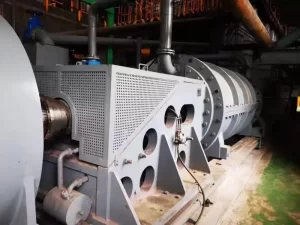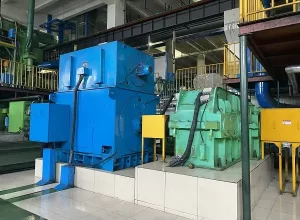Permanent Magnet Synchronous Motors find a wide application in industries due to their high efficiency, power density, and precise control. This blog explains the construction and working principle of the PMSM motor, advantages, and applications.

PMSM motors, like other electric motors, consist of two main components:
Stator: the outside is stationary and carries three-phase windings that set up the rotor magnetic field. These are often set out sinusoidal to obtain a smooth and sinusoidal flux density. The stator windings of the PMSM are designed to allow good heat dissipation.
Rotor: The inner rotor is mounted with permanent magnets that are usually made from the rare earth material like Neodymium-Iron-Boron (NdFeB) due to their high magnetic strength. The magnets are glued on the rotor at those points where they will interact with a rotating magnetic field created by the stator.
The PMSM motors can be classified based on the arrangement of the magnets inside the rotor:
Surface-Mounted PM (SPM): The magnets are mounted on the rotor surface. This construction has the advantages of lower complexity and, therefore, higher airgap flux density, producing higher torque. At high speeds, however, SPM motors require additional structural sleeves to retain magnets. An SPM motor requires a sleeve made of high-strength material outside the PM for protection.
Interior PM: The magnets are buried inside the rotor core. In such a configuration, better mechanical stability, higher operational speeds, and higher air-gap torque can be achieved. Locating the magnets inside the rotor creates multiple flux barriers that increase the saliency and allow a larger overload torque in a wide speed range. The reason why IPM motors are very often favored in high-speed applications is due to their robust rotor construction and the possibility of bearing higher centrifugal forces. In the case of an IPM motor, the permanent magnets are buried inside the rotor core.

The principle of operation for PMSM motors is the interaction of the magnetic fields:
1.Rotating Magnetic Field: The three-phase AC current in the stator windings develops a rotating magnetic field in the air gap between the stator and rotor.
2.Magnetic Attraction and Repulsion:The permanent magnets fitted on the rotor exert a constant magnetic field. This interacts with the rotating magnetic field from the stator, producing forces of attraction and repulsion.
3.Synchronous Rotation: The magnetic field of the rotor aligns itself through magnetic attraction and repulsion due to the rotation of the magnetic field at the stator. This constant alignment causes the rotor to rotate in tandem with the created rotation in the magnetic field by the stator. The speed of rotation is directly related to the frequency of the AC supply and the number of poles within the motor.
Some of the advanced control methods widely used in PMSM motors for applications that require precision speed and torque control include the following:
Field-Oriented Control (FOC):It provides a very widely used technique that gives outstanding dynamic performance, while assuring very precise control of the motor speed and torque. The principle works by transforming three-phase stator currents into two orthogonal components: one responsible for magnetic flux and the other for torque. FOC allows independent control of these components, hence assuring complete control of the motor operation.
Trapezoidal Control: Sometimes referred to as six-step commutation, trapezoidal control makes use of a simpler type of control. It relies on square-wave voltage pulses that are applied to the stator windings. While not quite as sophisticated, it is sufficient in applications where the need for high precision is less. Trapezoidal control is used in BLDC motors.
The principle of operation for the pmsm motor brings about some merits:
High Efficiency: PMSMs have small rotor losses and increased efficiency. The absence of rotor windings in PMSM motors eliminates rotor copper losses, hence making them much more efficient than induction motors. They also have a negligible rotor loss, meaning there is no heat loss.
High Power Density: The strong permanent magnets in PMSM motors mean that they have high torque output with compact dimensions, and will also assure high power-to-weight ratio. The fact that PMSM motors are more power dense makes them favorable for power density in small-scale applications.
Precise Control: Advanced control techniques, such as FOC, are available to provide high precision for speed and torque control. PMSMs find applications in applications requiring high accuracy and dynamic response such as industrial servo applications.
Wide Speed Range: PMSM motors can run over a wide speed range.
Low Noise and Vibration: The sinusoidal back-EMF waveform and precision control techniques result in smooth and quiet operation. PMSMs are less noisy than brushless DC motors.
High Reliability: Without brushes, commutators, and other such devices, the wear and tear on the motor is minimized, thus increasing its lifespan and reliability.
PMSM motors are widely valued for their unique features, enabling their application across various fields. In electric vehicles (EVs), PMSMs are favored for their high efficiency, power density, and broad speed range. In industrial automation, they excel in robotics, machine tools, and servo systems due to their precision control and dynamic response. Renewable energy systems, such as wind turbines and power plants, benefit from PMSMs’ ability to generate electricity efficiently. The aerospace industry leverages their high power density and lightweight construction, while HVAC systems utilize them in fans, pumps, and compressors for their efficiency and quiet operation.

PMSMs are also employed in consumer electronics for similar applications, including fans and pumps. They find further use in high-speed synchronous motors, belt conveyors, ball mills, sewage treatment plants, oil fields, textile equipment, air compressors, cable manufacturing, and plastic extruders, showcasing their versatility and indispensability across diverse industries.
ENNENG is one of China leading permanent magnet motor provider. ENNENG is also one of the “Hundred Innovative Enterprises” of Qingdao in 2018 and a member of Qingdao Motor Industry Association. The motors designed by ENNENG are highly efficient, very reliable, and feature-innovative. They provide a broad series of PMSMs to fit different industries and applications. These applications include:
Industrial PMSM : ENNENG’s PMSMs are used in mechanical driving of equipment at power stations, metallurgy, chemical plants, water treatment facilities, coal mines, textile factories, and in the manufacture of rubber, petroleum products, medicine, paper, cooling towers, food industries. These motors have helped companies in emission reduction, energy saving, as well as noising reduction.
PMSM for Mining : ENNENG’s motors are utilised in gold and coal mines.
PMSM for Oil and Gas: The motors of the company are in use in oil fields and oil wells.
PMSM for Water Treatment: ENNENG PMSMs are in use in water treatment plants.
PMSM for Tire Manufacturing: ENNENG motors are applied to both tire factories and in the production of rubber. They can be considered one of the best options for energy saving and efficiency enhancement for tire manufacturers. The company also offers intelligent monitoring and management systems to support intelligent factory upgrades.
PMSM for Textile: ENNENG’s PMSMs are applied in the textile industry, both on double twist machines and spinning frames.
PMSM for Pumps and Compressors: ENNENG supplies PMSMs for centrifugal pumps, air compressors among other pump systems. Their motors for air compressors are made from rare earth permanent magnet materials with soft starts and up to 50% energy savings. These motors also guarantee longer life for the compressor.
PMSM for Belt Conveyors: The low speeds with high power for belt conveyors in both ports and mining can use PMSMs made by ENNENG.
PMSM for Plastic Extruders: ENNENG produces permanent magnet synchronous motors for plastic extruders.
PMSM for Other Industries: ENNENG products also apply in industries like the metallurgy, chemical, medicine, and paper industry.
Quality, performance, and customer satisfaction are all concentrated points in the designing and building of PMSMs by ENNENG. With its global presence and commitment to customer service, it is a stalwart partner in those businesses that aim at upping efficiency with sustainability through high-performance PMSM technology.